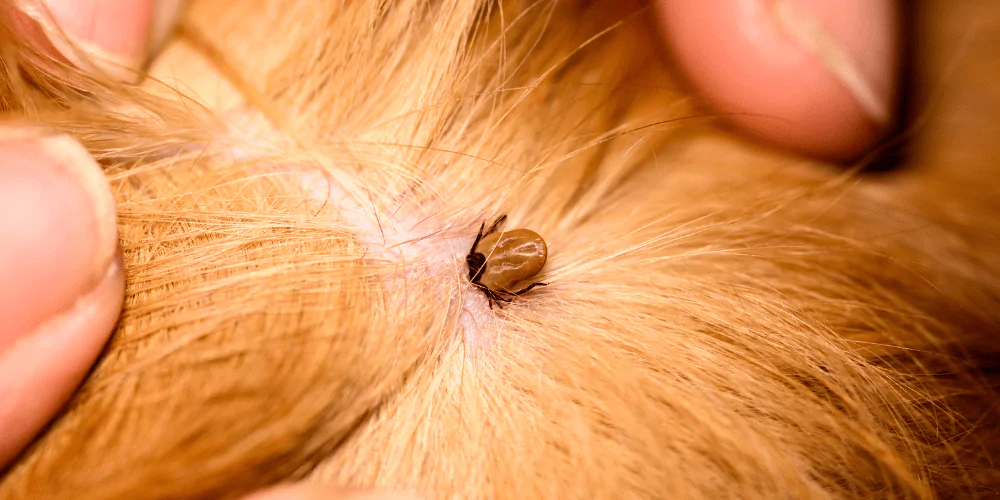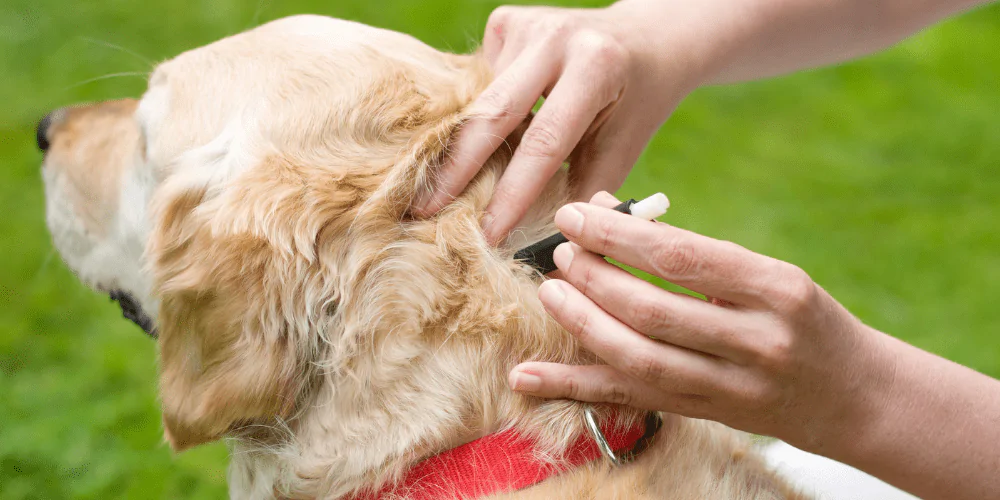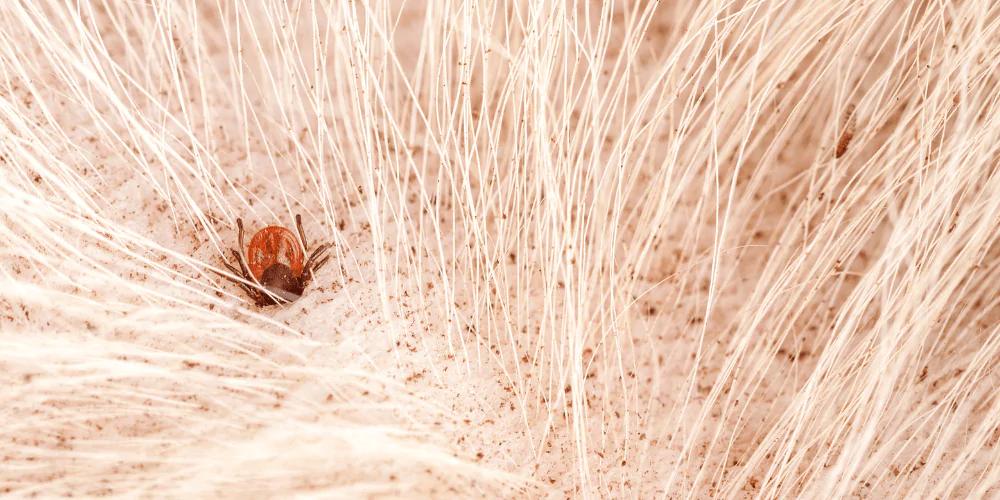
Ticks on cats and dogs: Spotting, removal, and treatment

Dr Lizzie Youens BSc (Hons) BVSc MRCVS
23 March 2023 | 6 minutes read
Part of being a responsible pet parent is looking out for creepy crawlies that could make your four-legged friend ill. Expert vet Dr Lizzie Youens shares how to spot a tick, safely remove one, and ways to prevent your pet from getting them in the first place.
- What are ticks?
> What does a tick look like on a cat and dog? - Signs and symptoms your cat or dog has a tick
- How do cats and dogs get ticks?
- How to remove a tick from your cat or dog
> How not to remove a tick - Tick treatment for cats and dogs
- Tick prevention for cats and dogs
- Other questions about ticks
> How to tell if your pet has a tick or scab
> Can I remove a tick from my pet without tweezers?
> What if a tick’s head stays in my cat or dog?

What are ticks?
Ticks are parasites that live off the blood of other beings. You can recognise them by their white, oval-shaped bodies and 8 spider-like legs. They are usually less than 1 cm long.
Ticks burrow their mouthparts into the skin and feed for several days to a week. They get bigger and turn darker as they feast, then drop off when they’re full.
What makes these crawlies especially creepy is that they can pass on infections to other animals.

> What does a tick look like on a cat and dog?
A tick can resemble a little wart or coffee bean with legs that’s sticking out of your pet’s fur. You’ll also be able to feel a small bump on their skin. They start small and white, but after a blood meal from your pet they turn a grey/brown colour and slightly larger
It’s good practice to do a tick check when your cat or dog returns from being outdoors, especially during the active tick season. This runs from around March – October in the U.K.
Run your hands all over their body, especially focusing on areas such as their:
- Head, including the neck, ears, and nose
- Feet
- Groin and belly
- Armpits

Signs and symptoms your cat or dog has a tick
As well as looking and feeling for a tick, you can also tell your pet has been bitten if they start showing signs of getting poorly.
This is because the bacteria that ticks carry can cause diseases such as babeosis and lyme disease.
Lyme disease is caused by the bacteria borrelia burgdorferi. It’s one of the more common diseases carried by ticks and can affect the kidney, heart, and nervous system if untreated. It also tends to affect dogs more than cats.
Here are the early symptoms of lyme disease:
- Lack of appetite
- Lethargy
- Swollen glands and joints
- Limping, lameness, stiff joints or discomfort
- A high temperature
Think that a tick bite may have progressed to Lyme disease? Speak to your vet as soon as possible and they’ll prescribe antibiotics if needed. Your pet cover could protect you from these unexpected vet bills, through all your pet’s adventures.
Babesiosis is caused by the babesia parasite. It attacks red blood cells and causes severe anaemia. Signs of babesiosis include:
- Acute weakness or collapsing
- Lack of appetite
- Dark urine
- Pale gums
- A swollen abdomen
- A fever

How do cats and dogs get ticks?
Your pet pal can pick up a tick on their adventures in grassy areas and woodland. They can even come across a tick in some gardens if you live rurally or close to wildlife.
The tick falls or climbs onto your pet’s fur when they brush past wherever the tick is.
Although ticks are lurking all year round, they’re especially common from spring through to autumn.
> How to tell how long a tick has been attached to your cat or dog
If the tick has started to swell and turn darker with blood, you’ll know they’ve been attached to your pet for at least a day or two.
But you shouldn’t wait for the tick to reach this point – remove them as quickly as possible to minimise the risk of infection.

How to remove a tick from your cat or dog
- Search for the tick and then gently part your pet’s fur so you have easy access
- Carefully push your remover tool under the tick to get a firm grip
- Twist clockwise a few times slowly to loosen the tick from the skin
- Check that no part of the tick has been left behind
- Destroy the tick in alcohol
If you’re still unsure whether you’re doing it right, ask your vet to show you how to remove a tick.
> How not to remove a tick
Tick removal should be done carefully and in the correct way. Otherwise, you’re increasing the chance of diseases spreading and leaving behind part of the tick’s head.
Remember not to panic, and stay away from:
- Squeezing, pulling, or crushing the tick
- Poking or prodding the tick
- Using vaseline to remove it
- Trying to burn it off

Tick treatment for cats and dogs
As mentioned, once you’ve removed the tick, kill it by putting it in a jar filled with rubbing alcohol.
Only a proportion of ticks carry disease, but if you are worried about your pet, speak to your vet. They can run tests to check for tick-borne disease, and give them the right treatment depending on whether they’ve been infected.
They can also offer preventative medication to stop more ticks from getting onto your pet.

Tick prevention for cats and dogs
Prevention is better than cure, so here’s some ways you can guard your pet pal against getting ticks:
- Using tick control products like collars, sprays, and spot-on treatments (use products recommended by your vet to make sure they actually work)
- Check pets after walks, or groom regularly and feel for ticks as you do so
- Cutting back the grass and vegetation in your garden
- Always having a tick removal tool and wipes with you on walks as well as in the house
- Asking dog walkers/pet sitters to regularly check your pet for ticks

Other questions about ticks
> How to tell if your pet has a tick or scab
One of the easiest ways to tell if your pet has a tick or a scab is to part their fur and get in close.
The tick will stick out as an obvious bump on the skin and has legs, while a scab is normally flat in shape.
> Can I remove a tick from my pet without tweezers?
Tweezers or a dedicated removal tool should always be used to remove a tick from your pet.
They make the job easier and reduce the chance of the tick’s head detaching from its body and staying under the skin.
> What if a tick’s head stays in my cat or dog?
If the tick’s mouthparts stay behind in your cat or dog, don’t panic. Try to clean the area with salt water and speak to a vet for advice.
Don’t use a disinfectant or alcohol as this can cause discomfort and increase the chance of diseases being passed on to your pet.
Keep your four-legged friend protected throughout their adventures with flexible pet insurance from Petsure.


